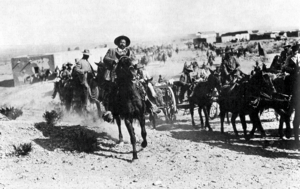Battle of Ojinaga facts for kids
Quick facts for kids Battle of Ojinaga |
|||||||
|---|---|---|---|---|---|---|---|
| Part of the Mexican Revolution | |||||||
 Pancho Villa and Siete Leguas in front of their Dorados |
|||||||
|
|||||||
| Belligerents | |||||||
|
|
|
||||||
| Commanders and leaders | |||||||
| Pancho Villa | Salvador Mercado | ||||||
| Strength | |||||||
| 5,500 | 4,500 | ||||||
| Casualties and losses | |||||||
| 35 | 3,500 | ||||||
The Battle of Ojinaga was an important fight during the Mexican Revolution. It happened on January 11, 1914. This battle ended the last strong point of the Federal Army in Northern Mexico. Rebel generals Toribio Ortega Ramírez and Pánfilo Natera García tried to take the city but couldn't. Then, Pancho Villa arrived with a large army. He forced General Salvador Mercado and his troops out of Ojinaga. After the battle, many bodies had to be burned to stop a serious sickness from spreading.
Contents
Background to the Battle
The Mexican Revolution began in 1910. It first ended with the rebels winning. President Porfirio Díaz left power in 1911. Francisco I. Madero became the new president. But in early 1913, a general named Victoriano Huerta betrayed Madero. Madero was killed, and Huerta became president.
Many former rebels and leaders did not like Huerta. They formed a group against him. Venustiano Carranza, the governor of Coahuila, became their main leader.
Pancho Villa returned to Mexico from the United States with only a few friends. But over time, more and more people joined him. He also got more weapons. Villa was made the leader of the revolutionary movement in Chihuahua. He organized the Northern Division. This army grew to over 5,000 men. It had soldiers on foot, on horses, and with cannons. It also had support teams for health, transport, and food.
Villa's army won several battles. They captured Ciudad Juárez. Then they moved towards Chihuahua City. General Mercado, leading the federal troops, decided to leave Chihuahua City. He moved his forces to Ojinaga in late November 1913. Ojinaga was a border town near the United States. This allowed Villa to take Chihuahua City on December 8, 1913.
Villa first sent General Panfilo Natera to attack Ojinaga. On December 31, 1913, Natera's troops reached the town. General Mercado had about 4,500 soldiers defending it. Natera tried to attack at night for three days. He attacked again on January 4, but his troops had to pull back. About 130 of Natera's soldiers were captured and shot.
Villa learned about Natera's defeat on January 4. At this time, Villa's men were also talking to American film companies. They offered to let the companies film Villa's battles. In return, Villa's army would get money. Only one company, Mutual Film, was interested. They signed a contract on January 5. The revolutionaries would get $25,000 upfront. They would also get a share of the money from the films.
When Villa heard about the defeat, he quickly prepared for a new attack. He gathered 1,500 men. They traveled for three days in the cold, without much food. When Villa arrived at the camp, his soldiers were very excited.
The Battle Begins
On January 10, at 6 AM, the soldiers prepared for battle. They were given ammunition. The military leaders told them to get close to Ojinaga. The plan was to surround the city. They would leave only the side facing the United States open. The soldiers were told to attack without their hats. If anyone ran away, they would be shot.
By evening, the attackers were in their positions. Their cannons were about 2,500 meters from the town. The next day, January 11, they got ready for a night attack. About 700 of Natera's men were kept in reserve.
The fighting started around 6 PM. Both sides fired cannons and rifles. Villa's men, led by Herrera and Hernández, entered the city through the cemetery. They pushed the defenders towards the Río Bravo river, which was the border. In the north, Trinidad Rodríguez attacked from a ranch. Some villagers helped the rebels by climbing the church bell tower.
In just a few hours, the revolutionaries quickly defeated the city's defenders. The federal soldiers dropped their rifles and ran. Many tried to swim across the river to Texas in the United States.
With Ojinaga taken, the Constitutionalist army now controlled the northern border. This allowed them to focus their fight on the rest of Mexico.
After the Battle
Pascual Orozco, a leader who had sided with the federal forces, escaped to San Antonio, Texas. But many other federal soldiers were captured in the United States. About 3,352 soldiers, including 8 generals, were taken. Also, 1,607 women who were with them were captured. They were sent to places like Marfa and Fort Bliss.
Only 35 of Villa's revolutionary soldiers died in the battle. They gained a lot of supplies. They captured 14 cannons, 100,000 rounds of ammunition, and 2,000 rifles. It is possible, but not certain, that the American writer Ambrose Bierce died during this battle. He was with the revolutionaries.
The films made during these days were soon shown in New York. However, not much of the actual battle was seen in the films. The father of the Madero brothers watched the film. He was surprised to see his son, Raúl, in the movie, fighting in the battle.
People Involved in the Battle
- Ambrose Bierce
- Enrique Creel
- John J. Pershing
- John Reed
- Luis Terrazas
See also
 In Spanish: Batalla de Ojinaga para niños
In Spanish: Batalla de Ojinaga para niños

